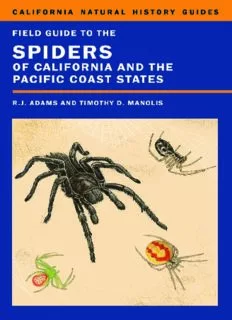
Field Guide to the Spiders of California and the Pacific Coast States PDF
Preview Field Guide to the Spiders of California and the Pacific Coast States
CALIFORNIA NATURAL HISTORY GUIDES FIELD GUIDE TO THE SPIDERS OF CALIFORNIA AND THE PACIFIC COAST STATES California Natural History Guides Phyllis M. Faber and Bruce M. Pavlik, General Editors Field Guide to the SPIDERS of California and the Pacific Coast States Text by R. J. Adams Illustrations by Tim D. Manolis UNIVERSITY OF CALIFORNIA PRESS Berkeley Los Angeles London University of California Press, one of the most distinguished university presses in the United States, enriches lives around the world by advancing scholarship in the humanities, social sciences, and natural sciences. Its activities are sup- ported by the UC Press Foundation and by philanthropic contributions from individuals and institutions. For more information, visit www.ucpress.edu. California Natural History Guide Series No. 108 University of California Press Berkeley and Los Angeles, California University of California Press, Ltd. London, England © 2014 by the Regents of the University of California Library of Congress Cataloging-in-Publication Data Adams, R. J. (Richard John), 1970- Field guide to the spiders of California and the Pacifi c Coast states / text by R.J. Adams ; illustrations by Tim D. Manolis. p. cm. — (California natural history guides ; no. 108) Includes bibliographical references and index. ISBN 978-0-520-27660-4 (cloth : alk. paper)—ISBN 978-0-520-27661-1 (pbk. : alk. paper) 1. Spiders—California—Identifi cation. 2. Spiders—Pacifi c States— Identifi cation. I. Manolis, Tim, 1951- II. Title. III. Title: Spiders of California and the Pacifi c Coast states. IV. Series: California natural history guides ; 108. QL458.41.U6A33 2014 595.440979—dc23 2013012465 Manufactured in China 23 22 21 20 19 18 17 16 15 14 10 9 8 7 6 5 4 3 2 1 Th e paper used in this publication meets the minimum requirements of ANSI/NISO Z39.48-1992 (R 1997) (Permanence of Paper). 8 Cover illustrations, clockwise from upper left : Aphonopelma steindachneri male, Microlinyphia dana female, Th eridion female, Diaea livens female. Illustrations by Tim D. Manolis. Th e publisher gratefully acknowledges the generous contributions to this book provided by the Gordon and Betty Moore Fund in Environmental Studies and the General Endowment Fund of the University of California Press Foundation. CONTENTS Acknowledgments ix INTRODUCTION 1 SPIDER FAMILY ACCOUNTS 27 Theraphosidae 28 Nemesiidae 33 Antrodiaetidae 35 Euctenizidae 39 Ctenizidae 43 Dipluridae 46 Mecicobothriidae 47 Hypochilidae 49 Filistatidae 52 Segestriidae 54 Caponiidae 56 Oonopidae 59 Dysderidae 61 Trogloraptoridae 63 Scytodidae 64 Sicariidae 65 Diguetidae 68 Plectreuridae 70 Pholcidae 73 Leptonetidae 77 Telemidae 79 Mysmenidae 81 Anapidae 82 Uloboridae 83 Oecobiidae 85 Mimetidae 88 Nesticidae 90 Theridiidae 93 Araneidae 110 Tetragnathidae 126 Pimoidae 131 Linyphiidae 133 Anyphaenidae 140 Miturgidae 143 Clubionidae 145 Corinnidae 146 Liocranidae 152 Prodidomidae 155 Gnaphosidae 156 Salticidae 167 Thomisidae 180 Philodromidae 187 Selenopidae 191 Sparassidae 192 Homalonychidae 195 Zoridae 197 Dictynidae 198 Cybaeidae 205 Hahniidae 209 Zodariidae 214 Tengellidae 215 Pisauridae 217 Zoropsidae 220 Oxyopidae 220 Lycosidae 223 Agelenidae 232 Amaurobiidae 237 Titanoecidae 241 Desidae 243 Amphinectidae 244 Glossary 247 Additional Resources 253 References 257 Index 287 PLATES FOLLOW PAGE 150 ACKNOWLEDGMENTS Th is book would never have been possible without the help and support of a great many people. Our spouses, Monika Davis and Annette Manolis, deserve special appreciation for their continuous support, both at home and in the fi eld. We would also like to thank Dr. Sarah Crews for her numerous reviews and constructive comments throughout the writing of this book, and Wendell Icenogle for so freely sharing his time, specimens, and expertise. Vital in the production of this book were the specimens, knowledge, and reprints housed at the California Academy of Sciences, and for their encouragement and assistance, the entire arachnology department deserves our deep appreciation, especially Dr. Charles Griswold, Darrell Ubick, Anthea Carmichael, Vic Smith, and Dr. Joel Ledford. We must thank Rod Crawford for freely sharing his unrivaled expertise on the spiders of Washington. For specimen identifi - cation we would like to thank Dr. G. B. Edwards, and for access to specimens, we extend our appreciation to Cheryl Barr (Essig Museum, University of California at Berkeley) and Rosser Garrison (California Department of Food and Agriculture). For help in the fi eld, we would like to thank Kathy Biggs, Pete Carmichael, Cary Kerst, Jonathon Martin, Kenneth Martin, Bruce Webb, and Stan Wright. Kevin Pfeiff er assisted with the translation of German arachnological publications. Numerous other people, all experts in their fi elds, generously provided feedback, access to publications, and insights. Without their help this book could never have been completed. Th ese include Dr. Marshal Hedin, Rick Vetter, Dr. Daniel Mott, Dr. Greta Binford, Dr. Jason E. Bond, Jozef Slowik, Dr. David Bixler, Dr. Herbert W. Levi, Th omas Prentice, Dr. Robb Bennett, Dr. David Shorthouse, and Chris Hamilton. Th e skills and discipline ix
Description: